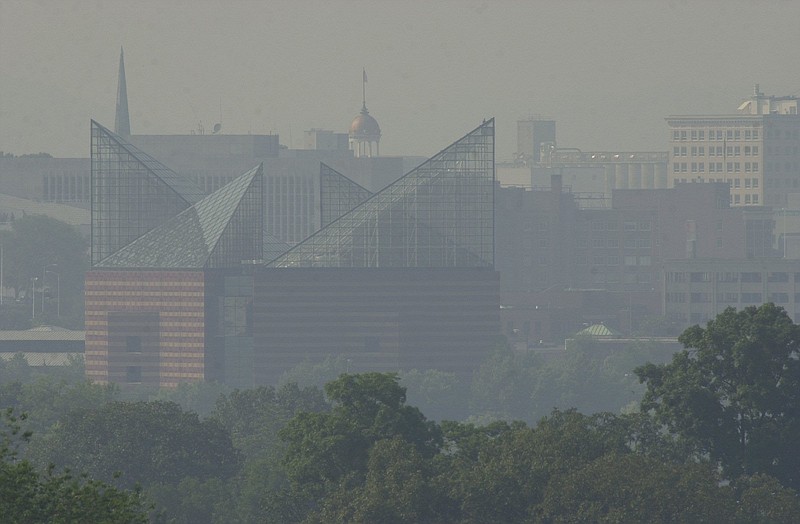In Mayor Andy Berke's "State of the City" address Thursday night, he referenced the 1969 mention by legendary CBS broadcaster Walter Cronkite of Chattanooga as "the dirtiest city in America."
Although Chattanoogans have searched national archives and databases to certify the actual pronouncement, the film footage is not readily found.
Indeed, it has become local 21st-century lore that the statement was widely discussed in the city at the time and by its politicians and city leaders in newspaper articles. But it wasn't. Berke's reference, meanwhile, was to show how far the city has come in 50 years but also to note that challenges remained ahead of it.
Nevertheless, 1969 appears to be a turning point for Chattanooga in remedying its manufacturing-heavy, infamously dirty air.
Archives show when the year started, the city was wrestling with a proposed air pollution control ordinance two years in the making. The then-Chattanooga City Commission had passed it on first reading; two more readings were required for it to become law. But newly appointed Mayor A.L. Bender wanted to see if it would pass the scrutiny of the incoming federal Department of Health, Education and Welfare (HEW); others were saying it didn't go far enough.
The new administration - President Richard Nixon had been inaugurated Jan. 20 - wasted no time in getting serious about what was then popularly called pollution. By mid-February, it was reported the HEW would require metro areas to meet standards of air pollution far better than Chattanooga's current status.
Cities were to have a maximum of 80 micrograms of suspended particulate per cubic meter of air per year, but the city's rate only a year earlier had been 160 micrograms. And only one of its reporting zones, Brainerd, could meet the proper rate (and that by 1 microgram).
(The standards were based on a 1961-1965 HEW study that showed the city was the worst of 60 cities in average of all its suspended particulates.)
Chattanooga "will have a lot of work to do in order to accomplish this goal," said John Allen Carter, director of the local air pollution control bureau.
By early March, the local air pollution control ordinance had passed, and city residents learned the new normal had forced five downtown schools to convert to a cleaner fuel and that the metro area's 12,600 junked cars would no longer be able to be burned, at least within a mile of the city, as they had been in the past.
That same month, the Volunteer Army Ammunitions Plant (VAAP), which employed 4,000 people and manufactured 40 percent of the world's TNT, was labeled in a report by HEW "the worst single federal source of air pollution" in the United States.
In congressional hearings in late March, then-U.S. Rep. Bill Brock, R-Chattanooga, and then-U.S. Sen. Howard Baker, R-Tennessee, demanded action.
"The Tyner plant is the worst polluter of its type in the country," Baker said, "and it being a government installation is a crying shame." He later threatened to hold congressional hearings at the edge of Chickamauga Lake, exposing what was reported as "hazy, yellow air" and contaminated water.
An angry Brock, calling the Tyner residents exposed to the nearby pollution "the most patriotic folks in America," told the Army general responsible for TNT production "to fish or cut bait" in cleaning the air.
In August, the National Air Pollution Control Administration scheduled a first-ever evaluation of the emissions inventories of Chattanooga area manufacturing plants.
Similarly, it was reported in October the city's new ordinance would require all pollution sources to file their plans with the local air pollution bureau for complying with the standards set in law. At the same time, the bureau noted in its monthly samplings that the South Broad sector of the city had jumped in the previous month from 60.4 tons of fallout to 93.2 tons per square mile. It was, said the bureau, "a matter of special concern."
That same month, the federal Department of Defense announced a $40 million modernization at the VAAP plant, which was said to be able to reduce 98% of its pollution.
But the city's reputation was growing. Then-state Rep. Ray Albright, at an October seminar on the environment in St. Louis, encountered speaker Charles Johnson, an HEW official who was an expert on air and water pollution.
"You're from Chattanooga, Tennessee," he said. "That's the worst pollution area in the country."
Albright, reflecting on the TNT plant and the city dump in East Chattanooga smelling "like a burst gas main," said change was mandatory.
"The fact is very simple," he said. "This pollution, regardless of the source, has got to be solved as quickly as possible. A lot of things are going to have to take second place. There is nothing more important than the health and safety of people."
A 1975 Chattanooga News-Free Press story referred to the city no longer being "the dirtiest city in America" but didn't mention Cronkite, and a 1991 article referenced then-Mayor Gene Roberts returning years earlier to his home, "known as the dirtiest city in America," but didn't cite Cronkite, either.
No matter. Even before the CBS broadcaster referenced the city, said to be in October 1969, it had begun work to reverse its foul fortunes. Fifty years later, we can be grateful.
